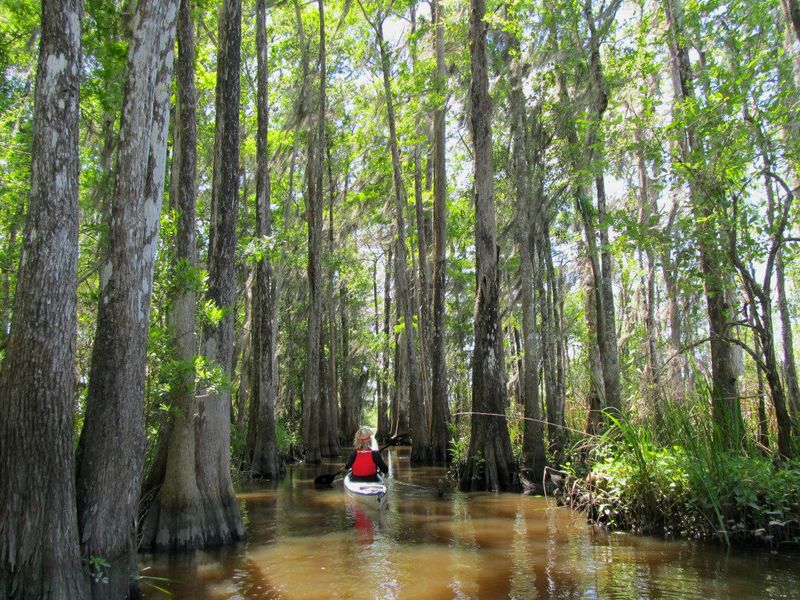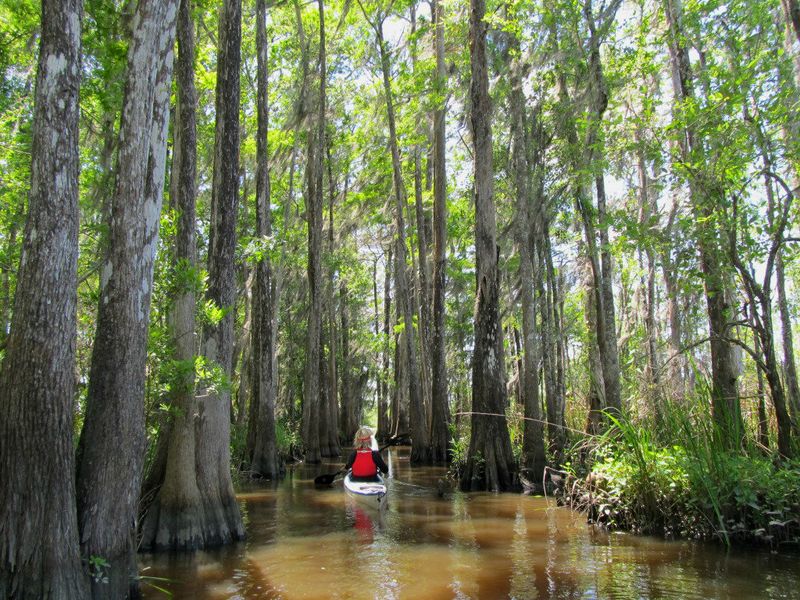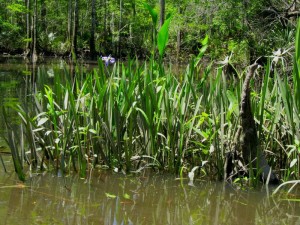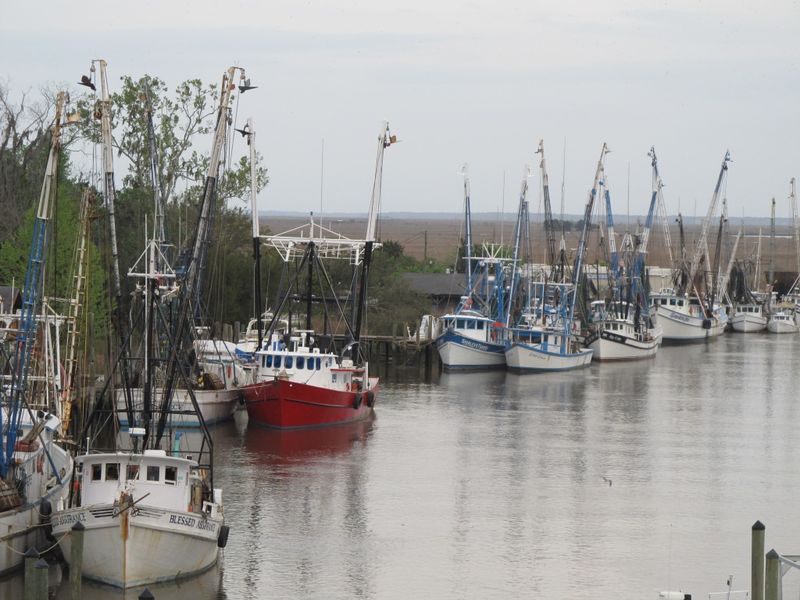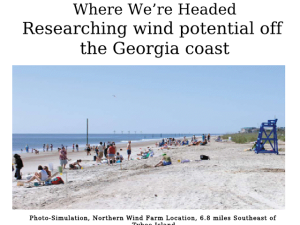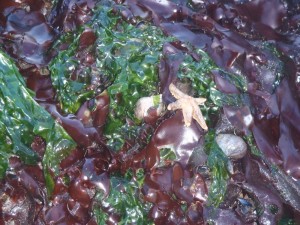By Mary Fairchild
(Rifle Cut) Buffalo Swamp Natural Area/Cathead Creek,a tributary of Georgia’s Altamaha River.
Just as Egypt used slave labor, the channel pictured above(Rifle Cut) was dug out in the 1820s by slaves to shorten the water route to Darien: “Straight as a rifle shot through the cypress swamp and just as narrow.”
“Mary, can you smell that? … it’s sweet and fresh,” Danny Grissette, owner of Altamaha Coastal Tours incited with a deep breath. “You’re right. It’s fresh and not what you’d expect in a swamp,” I added as we paddled deeper into the ancient tidal forest along the Altamaha River.
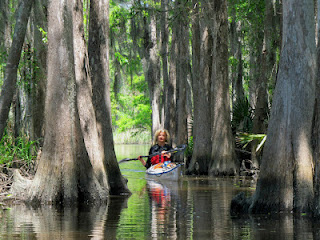 Paddling between ancient cypress trees in a globally rare tidal forest.
Paddling between ancient cypress trees in a globally rare tidal forest.
My first time paddling in Georgia was focused solely on ocean paddling. This year, I was re-visiting Cumberland Island before heading up to the Buffalo Swamp Natural Area with Altamaha Coastal Tours.
Whereas my kayaking had been all about technique and speed, now it was all about “an ecologically important place that you need a boat to see” and the pace was purposefully slow….
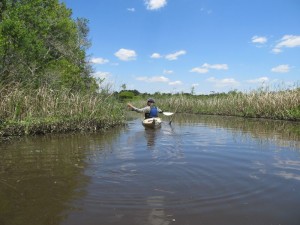 (Danny Grissette; Altamaha Coastal Tours, Darien Georgia.)
(Danny Grissette; Altamaha Coastal Tours, Darien Georgia.)
The tidewater ecosystem was perfect for the production of rice. Tides flooded the fields twice a day and the fresh water from the river protected the crops from the saltwater. The abandoned irrigation canals of the old rice plantations provide miles of waterways to paddle. Danny was pointing out a peculiar grass next, “That’s bulrush… are you familiar with that?” “Oh, yeah… the story of Moses,” I replied as I began to look around for the alligators… thinking of the Nile now and it’s crocodiles.
Over 130 rare and endangered species of plants and animals, some found no where else, find refuge among the swamps which totally surround and insulate the Altamaha River. The Altamaha River has been compared to the Nile by its impresssive volume which pumps 100,000 gallons of fresh water every second into the sea. Much depends on that amount of water that flows downstream… If there’s too much withdrawal, either due to large municipal wells, or even the cumulative combination of smaller withdrawals, there may be serious problems for the natural vegetation in the area.
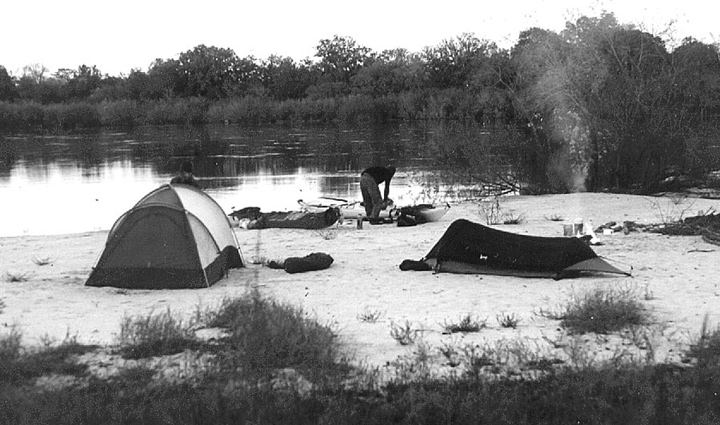 Picture was taken 20 yrs. ago—“Amazing to be on this river and having it to yourself. It’s still the same today! Some things don’t change.” Altamaha Coastal Tours Facebook
Picture was taken 20 yrs. ago—“Amazing to be on this river and having it to yourself. It’s still the same today! Some things don’t change.” Altamaha Coastal Tours Facebook
The best advocate to Georgia’s environment is the stewardship of citizens who are suspicious of developers and commercialism. As more projects go to sea for renewable energy sources, questions of how wave and tidal power devices might affect marine life are being discussed along Georgia’s coast. Currently, Jekyll Island and Tybee Island are the two locations with the best potential for connecting power from an offshore wind farm to a transmission grid.
Aspen Skiing Company’s Auden Schendler, also a kayaker, reports that he has rethought his position on renewable-energy credits because he believes that RECs do little to encourage new clean-energy development. Most ski resorts make money on real estate today not on lift tickets. (7)
“We need to be careful not to just do things when they truly don’t do environmental good, just because we have that message out there… this lacks integrity. If you bring more people into these natural areas you’ll have more traffic. Do we really want urban sprawl in a rural pristine environment? Soon you will also have water quality issues and air-quality issues there…” Auden Schendler
Plans that truly respect the latest scientific research as well as firsthand experience of local residents should be reflected in support from the central government. It will be an interesting and often contentious challenge ahead as scientists, planners, policymakers, and everyday citizens create and enact plans that truly live up to their green claims. We need to allow more time for thorough review by the local communities and by relevant experts.
In Georgia, data collected by Skidaway Institute of Oceanography scientists indicates an average wind speed of about 16 mph offshore. That’s enough for the Georgia coast to score a respectable four on the seven-point scale used to rank wind. Modern wind turbines are larger than previous generations, some as tall as small skyscrapers. That height makes them an eyesore to some and consequently a sitting challenge. But Georgia’s gently sloping coast (the continental shelf stretches 80 miles off Georgia) offers an offshore solution. The waters 10-20 miles off the coast are still shallow enough to allow the building of turbines, but that distance would put a wind farm out of view from shore. The U.S. has no offshore wind farms yet. Large wind projects proposed near Cape Cod and Long Island are farther along than is Georgia Tech’s but have met with concerns about ruined views and injuries to birds. (1)
The “Environmentally Responsible Wind Power Act of 2005,” proposed to eliminate federal tax incentives for the development of wind power within 20 miles (which is the horizon of a national seashore, a national lakeshore or a national wildlife refuge) of a “highly scenic” area, including all offshore projects. The bill was set up to protect America’s most scenic treasures – national parks, world heritage sites, national lakeshore and seashore sites. The act does not stop construction of the wind power just the federal subsidy of it for giant wind turbines within 20 miles. This helps us to re-think what we are doing to some of our most pristine coastlines.
Freshwater tidal marshes are globally rare and occur along free-flowing coastal rivers and they are vital to sustaining all life on earth. The Altamaha River and its swamps play a vital role in supporting the rich estuary downstream.
Beneath the surface of the Atlantic Ocean exists a thriving ecosystem of fish, invertebrates, seal, and whales. The North Atlantic Ocean has one of the largest plankton blooms in the world every spring. The change in color of water due to plankton bloom can be seen by NASA satelites. Plankton is one of the most important organisms in the ocean. Although usually quite small, anything that drifts in the ocean’s currents is technically considered planktonic. Jellyfish are considered plankton. If plankton where unable to grow for some reason all life in the ocean would suffer.
The bays, estuaries, and salt marsh along our coasts are considered nurseries for commercial fisheries. The larvae of fish, crustaceans and other marine animals, called meroplankton, if they survive, they will grow into nekton or free-swimming organisms.
“Anytime you alter something that’s so important as a habitat and as a source of nutrients for the other commercial fisheries you’re really playing with fire.” Roylan Hadworth Sealy, Sr. Research Assistant Shoals Marine Laboratory of Cornell University (8)
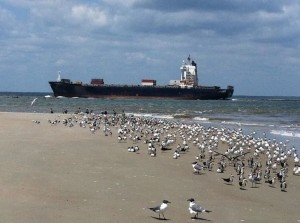 Freighter headed for Savannah off the northern tip of Tybee Island; a roosting area for shorebirds.
Freighter headed for Savannah off the northern tip of Tybee Island; a roosting area for shorebirds.
On the northern coast of Georgia, the Tybee Island National Wildlife Refuge is a 100-acre home to waterfowl, crustaceans and marine reptiles. The refuge is not open to the public, but many of the wildlife species from the island are seen near the tourist areas on the island.
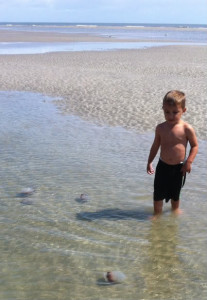 Local Tybee Island resident watching the trapped cannonball jellyfish during low tide a few weeks ago.
Local Tybee Island resident watching the trapped cannonball jellyfish during low tide a few weeks ago.
“Jellyfish thrive in all of the world’s oceans, and there is mounting evidence that human activity in coastal zones, like overfishing, is creating conditions that could cause populations to skyrocket.” The Living Sea (6)
The city of Tybee Island said “yes” to wind energy this past February. A windmill farm with its flashing red lights will be seen from the beach at only 6.8 miles Southeast off Tybee Island. Local communities need some time to stop and think about the locations for clean energy. Usually wind turbines are located in wind farms containing 20 or more, but some can exceed 100. At night, the flashing red lights can be seen for 20 miles. Unfortunately, they work best along scenic coastlines and ridge tops… What do you think? Just 7 miles off the coast of Kent, England, is Thanet Wind Farm, the world’s second largest offshore wind farm since February 2012.
We don’t know whether the underwater acoustics of the turbines harm marine life or how fish and marine mammals might interact with the turbine’s rotors. Many marine species rely on the earth’s magnetic fields for migrating and searching for food and we don’t know yet if electromagnetic fields will repel or attract certain species. Wave, tidal, and hydrokinetic power devices, and the cables that bring electricity they generate to shore produce similar electromagnetic fields and there has not been a lot of research on whether or not marine life might be affected.
By 2020, the state of Maine hopes to produce thousands of megawatts of wind power from turbines on and off shore. The National Wildlife Refuge System hopes to monitor the flight and feeding habits of birds and bats to help with the placement of ocean energy projects.
“Seabird productivity periodically declines on some islands, because the herring disappear and chicks starve. We want to understand where birds are foraging, and what’s going on with fish in the Gulf of Maine.” Beth Goettel
This is a picture at low tide(picture above) in Cobscook Bay, Maine, when I was kayaking there last September. Nearby, Ocean Renewable tidal power was just getting settled in. They have described their tidal turbine as “a giant lawnmower.” Cobscook Bay is a semi-enclosed sea that extends almost 200 miles. The highly convoluted shorelines, intense tidal currents, and the cold waters all contribute to the areas diverse marine inhabitants. Local fishermen wonder if the areas will be closed off to fishing around the turbines since no one has answered that yet. Another unanswered question is why wind turbines are placed only 10 miles offshore when the University of Maine experts suggested 20-50’ was less likely to interfere with coastal marine fisheries. (Fisherman’s Voice, 9/11; Vol. 16, No. 9) Noise Problems on Maine’s Fox Islands ; YouTube: Offshore Windmills Could Harm Maine Lobster.
When the Maine coastal current meets low pressure zones created by the wind energy extraction around the turbines, seafloor water is pulled to the surface and is partly diverted around the upwelling of the cold water taking the lobster larvae with it.
From the mid-19th century through the late 20th century, more than a third of the San Francisco Bay was filled and often built on. The state and federal governments have spent hundreds of millions of dollars since 1996 on projects to restore tidal wetlands and only 1% has been restored so far. It is difficult and expensive to reverse mistakes.
San Francisco Bay and the Sacramento-San Joaquin Delta remain perhaps California’s most important ecological habitats. California’s Dungeness crab, California halibut, and Pacific Salmon fisheries rely on the bay as a nursery. The few remaining salt marshes now represent most of California’s remaining salt marsh, supporting a number of endangered species and providing key ecosystem services such as filtering pollutants and sediments from the rivers.
Estimates of the value of tidal flats have been increasing as scientists understand more about the vital role that tidal flats play in sustaining urban areas as well as marine ecosystems. We have to be stewards of our own resource. We have to look after it and be interested in it. It all depends on how we view things….
I had started “forest gardening” years ago when I had some serious issues with the poison oak on our wooded lot. We don’t have grass to fertilize and cut anymore! I was so impressed with the natural vegetation and trees that, when we purchased our cabin in Wisconsin I dug up any existing grass and filled it in with native plants and trees as well.
Not only is forest gardening much less labor intensive, perennials reseed themselves and the soil enriches itself just like it does in the natural forests with fallen fruit, leaf litter, and other organic matter. I planted clumps of wildflowers in patches of sunlight and researched types of flowers native to my area and planted them. Woodland gardens require relatively low maintenance and falling leaves add to rather than detract from the appearance.
Ocean renewables, which may seem to be an ideal source of non-polluting energy, are appearing to be a much more complicated issue. The debate between ethics and economics, when human activity threatens the existence of species and their habitats, could go on and on.
References
- Wind Project Picks up Speed , Savannah Morning News; 2012.
- Severn Barrage , Wikipedia.
- The Altamaha River Bioreserve, Sherpa Guides; Richard J. Lenz.
- “The Full Circle: A Historical Context for Urban Salt Marsh Restoration,” David G. Casagrande; Yale School of Forestry and Environmental Sciences.
- “Georgia,” Kap Stann, Moon Books.
- Exposure Special, “The Living Sea,” Outside Magazine; May 2012; p. 82.
- “Snow Job,” by Elizabeth Hightower, Outside Magazine; Nov. 4, 2008.
- Rockweed Coalition, Roylan Hadworth Sealy, Sr. Research Assistant, Shoals Marine Laboratory of Cornell University.
- Marine Ecosystem Dynamics Modeling: Altamaha River

